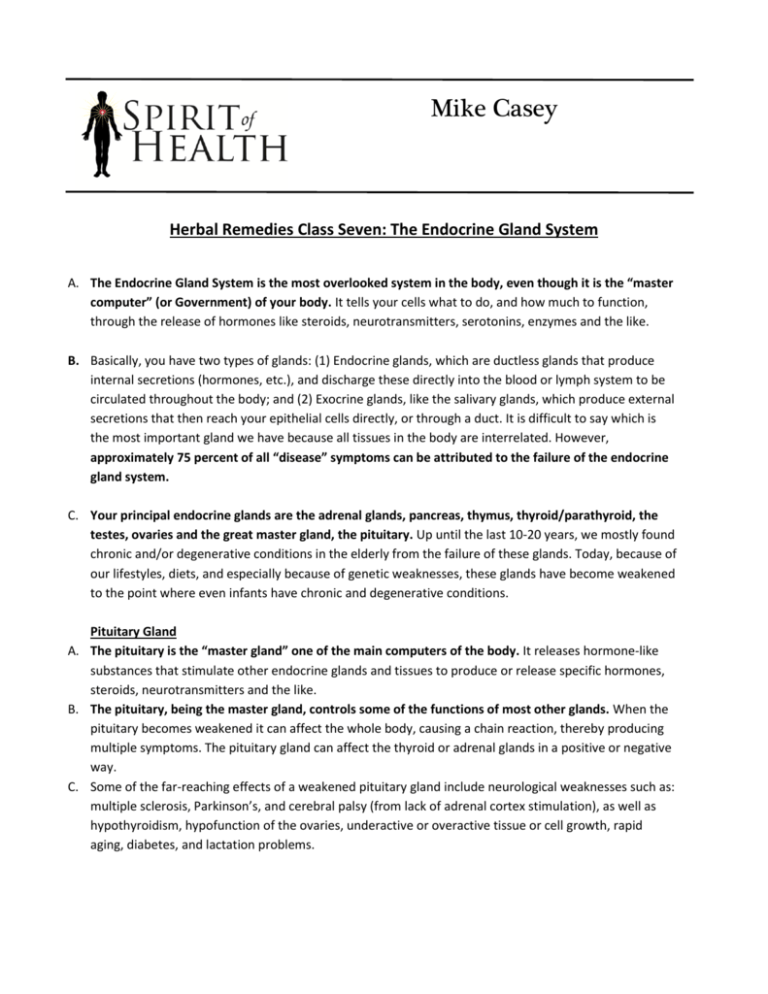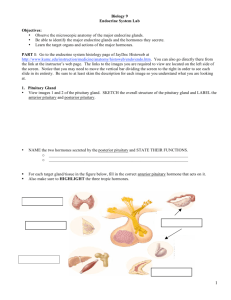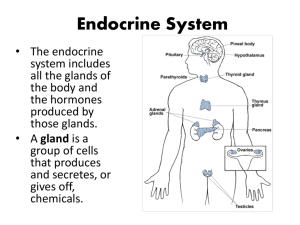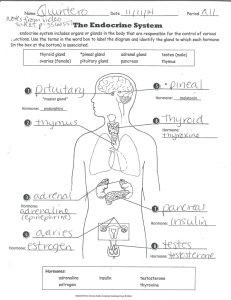Herbal Remedies Class Seven: The Endocrine Gland System
advertisement

Mike Casey Herbal Remedies Class Seven: The Endocrine Gland System A. The Endocrine Gland System is the most overlooked system in the body, even though it is the “master computer” (or Government) of your body. It tells your cells what to do, and how much to function, through the release of hormones like steroids, neurotransmitters, serotonins, enzymes and the like. B. Basically, you have two types of glands: (1) Endocrine glands, which are ductless glands that produce internal secretions (hormones, etc.), and discharge these directly into the blood or lymph system to be circulated throughout the body; and (2) Exocrine glands, like the salivary glands, which produce external secretions that then reach your epithelial cells directly, or through a duct. It is difficult to say which is the most important gland we have because all tissues in the body are interrelated. However, approximately 75 percent of all “disease” symptoms can be attributed to the failure of the endocrine gland system. C. Your principal endocrine glands are the adrenal glands, pancreas, thymus, thyroid/parathyroid, the testes, ovaries and the great master gland, the pituitary. Up until the last 10-20 years, we mostly found chronic and/or degenerative conditions in the elderly from the failure of these glands. Today, because of our lifestyles, diets, and especially because of genetic weaknesses, these glands have become weakened to the point where even infants have chronic and degenerative conditions. Pituitary Gland A. The pituitary is the “master gland” one of the main computers of the body. It releases hormone-like substances that stimulate other endocrine glands and tissues to produce or release specific hormones, steroids, neurotransmitters and the like. B. The pituitary, being the master gland, controls some of the functions of most other glands. When the pituitary becomes weakened it can affect the whole body, causing a chain reaction, thereby producing multiple symptoms. The pituitary gland can affect the thyroid or adrenal glands in a positive or negative way. C. Some of the far-reaching effects of a weakened pituitary gland include neurological weaknesses such as: multiple sclerosis, Parkinson’s, and cerebral palsy (from lack of adrenal cortex stimulation), as well as hypothyroidism, hypofunction of the ovaries, underactive or overactive tissue or cell growth, rapid aging, diabetes, and lactation problems. Pineal Gland A. The pineal gland is a small, flattened, cone-shaped gland located behind and just above the eyebrows. Scientific research hasn’t revealed much about this endocrine gland as of yet. We know that it synthesizes melatonin, which is a hormone that relaxes you and aids in the sleep process. Melatonin may affect skin and hair pigmentation. Melatonin is inhibited by light striking the retina. The pineal gland is regulated by light. A. B. C. D. E. Thyroid and Parathyroid Glands The thyroid consists of two lobes in the anterior portion (front) of the neck. The parathyroid consists of four or more small glands on the back of the thyroid. The job of the thyroid/parathyroid glands includes increasing and/or decreasing the following: metabolism; the ability of cells to absorb and use glucose; protein metabolism for growth; the use of fats; rate and strength of the heart beat; rate and depth of respiration; and the rate of calcium absorption from blood, intestines, bones and kidneys. Since many people choose to consume “cooked” dairy products and refined sugars (highly mucusforming), they develop congestion throughout the sinus cavities, head area, throat, bronchi and lungs. The thyroid/parathyroid, since located in the throat area, also become congested and either become hyperactive (overactive) or, as in most cases, hypoactive (underactive). The symptoms of hypothyroidism (low thyroid function) include: bone loss, improper bone growth, brittle and rigid fingernails, hair loss, cold hands and feet, a dislike of cold weather, heart arrhythmias, heart attacks, depression, connective tissue weakness, scoliosis of the spine, arthritis, fatigue, slow metabolism, obesity, hot flashes, cramping, spasms and growth issues. The symptoms of hyperthyroidism (overactive thyroid) include: goiter, protruding eyes, hyperactivity, thyrotoxicosis, and excessive growth issues. Since the thyroid/parathyroid affects the body’s ability to utilize calcium, we find that bone problems, depressive disorders and connective tissue weaknesses can be eliminated by regenerating the thyroid/parathyroid glands. Hyperthyroidism is easy to overcome through detoxification. Thymus A. The thymus gland consists of two pinkish/gray, flat-looing, symmetrical lobes and is located in the middle of your sternum in front of and above your heart. The thymus gland is considered the master gland of the immune system. It is large in children, but becomes much smaller with age. Because of diet and lifestyle, the thymus gland can be almost completely atrophied by the time of old age. B. Your thymus gland is essential to the maturation of thymic lymphoid cells called T-cells. T-cells are smallto-medium-sized lymphocytes (white blood cells) that are a part of a class of immune cells called NK or natural killer cells. These cells, along with the B-cells (bone marrow cells), are the Marine and Navy Seals of your body’s police force. Adrenal Glands A. The adrenal glands are located on top of each kidney, and, except for the pituitary, the adrenal glands are possible the most important glands in the body. The reason for this is two-fold. B. First, they produce neurotransmitters, which are essential for brain and nerve function. These neurotransmitters include epinephrine (adrenaline), norepinephrine and dopamine, which affect the sympathetic and parasympathetic nervous system, turning nerve responses on or off. This affects almost all tissues in the body, including the heart, vascular system, intestines, skin and kidneys. C. The second reason for the importance of the adrenal glands is the cortex (or outer portion) that produces cortical-type steroids or hormones. Many of these steroids act as anti-inflammatory compounds, which are vital to combating inflammatory processes within the body. These steroids affect muscle, nerve, gastrointestinal and cardiovascular tissues. D. All these steroid-type hormones are synthesized from cholesterol, which also acts like or is used by the body as an anti-inflammatory agent or lipid. All things happen for a reason. If your cholesterol is building up on vascular walls or in tissues, what does that tell you? Remember that cholesterol is an antiinflammatory agent. It if is building up in your body, or if your liver is producing too much of it, this tells you that you have too much inflammation in your body. E. Since most people choose to eat a predominantly acid-forming diet, acidosis conditions of the body begin to take place. Acidosis and inflammation are virtually the same thing. Added to acidic diets are the acid-type hormones (testosterone and estrogen mainly) that get out of balance and further the acidosis. F. Low blood pressure (systolic under 118) is always an indicatory of adrenal weakness, and at least 50 percent of high blood pressure cases reflect adrenal weakness as well. A healthy blood pressure is 120130 systolic (top number) over 60-70 diastolic (bottom number). Long-term effects of adrenal weakness include, but are not limited to: asthma, multiple sclerosis, Parkinson’s, M.S., cerebral palsy, panic attacks, shyness, impatience, low energy, low endurance, anxieties and emotional sensitivities, ovarian cysts, excessive bleeding, prostatitis, prostate cancer, cholesterol placquing and tremors. Pancreas A. Your pancreas is both an endocrine and an exocrine gland, meaning that it produces hormones (insulin) that are secreted directly into the blood, and other substances (enzymes, etc.) that are secreted by ducts. B. The endocrine portion consists of cells called islets of Langerhans, which secrete various hormone-like substances that assist the body in utilization and energy factors. The various cells that comprise the islets of Langerhans are as follows: -Alpha cells: secrete glucagon, which increases blood glucose levels by stimulating the liver to convert stored glycogen to glucose. Glucagon also increases the use of fats and excess amino acids, for use as energy. -Beta cells: secrete insulin, which decreases blood glucose levels. Insulin acts as a “driver” that transports glucose through cell membrane walls. It facilitates the conversion of glucose to glycogen and is thought to be involved in amino acid synthesis. -Delta cells: secrete somatostatin, which inhibits the secretion of glucagon, the secretion of insulin, a growth hormone from the anterior portion of the pituitary gland, and the secretion of gastrin from the stomach. Ovaries A. The ovaries are two almond-shaped glands found in the females. The ovaries have two functions. One is to produce the reproductive cell (ovum) and the other is to produce hormones. The ovaries are found on each side of the pelvic cavity, each attached to the uterus. B. Each ovary consists of two parts: the cortex (outer portion) and the medulla (inner portion). The cortex consists of mainly various types of follicles (small sacs). Each follicle has an ovum (egg) and a small, yellow endocrine gland (corpus luteum). This gland (corpus luteum) secretes both estrogen and progesterone. It should be noted that pro-hormones from the adrenal glands are necessary for proper progesterone production in the corpus luteum. C. The FSH (Follicle Stimulating Hormone) from the hypothalamus induces the release of the ovum (egg). The estrogen-releasing hormone – LH (Luteinizing Hormone) – comes from the anterior portion of the pituitary gland. Both of these are vital to proper ovulation. D. Estrogen is an acid-type hormone that stimulates tissues in many different ways. The most notable way is stimulating of the inner lining of the uterus to bleed each month, causing menstruation. A female also produces a form of estrogen in her liver, fat cells and adrenal glands. Estrogen must always be counterbalanced by a steroid called progesterone. Progesterone is a steroid produced in the ovaries and the adrenal glands. Progesterone needs a pro-hormone, DHEA, produced in the adrenal glands, to be properly produced. Therefore, when the adrenal glands are hypoactive, this can affect the production and release of progesterone, leaving a woman estrogen dominant, which can cause a domino effect creating extensive cellular acidosis and leads to ovarian cysts, uterine fibroids, fibrocystic issues, female cancers and other conditions. Testes/Testicles A. A male has two oval-shaped testicles located in the scrotum. These are the male reproductive glands and are a part of the endocrine gland system. Reproductive cells called spermatozoa are produced in the testes. These glands also produce testosterone and inhibin. B. Testosterone is secreted by the interstitial cells call “Cells of Leydig,” and inhibin is secreted by the sustentacular cells. It should be said here that testosterone (steroid) is like estrogen in its aggressive nature in creating cellular changes. Progesterone is a cortical-type steroid produced in the adrenal glands that counterbalances estrogen and testosterone, especially when they create inflammation. Testosterone is also produced in the cortex of the adrenal glands of both males and females. C. Testosterone accelerates growth and cellular function, as well as stimulates the flow of blood. It has similar characteristics to estrogen in affecting secondary sexual characteristics as well. D. All of the endocrine glands are vital to the health and well-being of the physical body. It is enough to say that every tissue in your body interacts with every other tissue. This is why we should look at the body as a whole entity, working as one for the well-being of itself. Most people do not think of strengthening their cells, so they keep passing down genetically weakened tissue generation after generation and now each generation is weaker than the last. Your glands are the bosses (controllers and regulators) of the cells, tissues and organs of the body, keep them healthy! E. Keep in mind, no matter what gland is having issues or what “disease” symptoms are going on, the basis of what to do is always the same: Alkalize, Detoxify, Eat the foods God designed, in their whole food form, Remove stressors (toxins, poisons….) and use herbs to boost the regeneration and cleansing process and for targeting specific organs/body systems! Herbs for the Endocrine Glands A. Alfalfa: Alfalfa, also known as “King of the Herbs”, is a great alkalizer and naturally high in many essential vitamins and minerals, and very high in protein. The alfalfa plant has an extensive root system that can reach as far as 60 feet into the soil, which allows it to absorb more vitamins and minerals than the average plant. It is great for enhancing the endocrine glandular system, especially the adrenal and pituitary glands. It is high in chlorophyll, cleanses the body, bonds to inorganic minerals for elimination and strengthens the whole body. B. Astragalus Root: Astragalus is a tremendous cellular proliferator (strengthens cells), and strengthens the adrenal glands, nervous system and the whole endocrine system. It is most popular for stimulating the immune system by increasing the activity of the white blood cell count. It boosts energy levels, increases stamina and is safe for long term use; making it ideal for chronic fatigue, or for those who just need a little boost of energy. Astragalus is also though to increase cardiac output and strengthen the cardiovascular system. C. Black Walnut Hull: Black walnut hull is mainly known for being one of the most powerful antiparasitics and great for killing microorganisms (bacteria, fungi, yeasts, etc.). It is also a cellular proliferator (strengthens cells), increases the oxygenation of blood cells and is a detoxifier. It is recognized as a thyroid stimulant since it is rich in the trace mineral iodine as well as other minerals. It strengthens and stimulates the immune system, promotes lymph and bowel movement and strengthens the bones. D. Deer Antler: In the Spring antlers naturally grow at an astounding rate of up to 2 cm daily. This displays the powerful growth factors and special nutrients involved to grow such tissue so quickly. Deer antler has a long and illustrious history as a muscle building, blood building, kidney and adrenal fortifying agent of physical transformation. It is loaded with growth factors, anti-inflammatory action and regenerative power. It improves athletic performance, improves lean muscle mass, increases production of red blood cells, improves mental facility and acuity, has anabolic and growth stimulating properties, boosts function of the whole endocrine system and cardio-vascular system, accelerates wound healing, and slows the deteriorating effects of aging. E. Eleuthero: Eleuthero, also known as “Siberian Ginseng” is generally a less expensive alternative to “true” Asian or Panax ginseng. It is one of the great endocrine gland herbs, especially great for the adrenal glands. It strengthens cells, improves vitality and stamina, increases neurotransmitter and steroid production, strengthens the pancreas and helps control blood sugar issues, helps strengthen the immune system, helps lower blood pressure, increases circulation and strengthens the heartbeat. F. Fo-Ti: Fo-Ti, or also called “He-Sho-Wu”, is one of the most important traditional Chinese “longevity herbs”. It is a rejuvenator having a powerful effect on the endocrive glands, which in turn, strengthens the whole body. It is a famous adaptogen that modulates the hormones, tonifies the kidneys and liver, increases blood flow to the heart and strengthens the whole cardiovascular system and is slightly sedative and calming to the nervous system. G. Panax Ginseng: Panax ginseng is a powerful “adaptogenic” herb that has a history of herbal use going back over 5,000 years and is regarded as having almost magical powers to promote health, body vigor and to prolong life. It stimulates function of the endocrine glands, increases energy levels, boosts physical performance and endurance, helps increase strength, enhances immune system function, mental function, balances blood sugar levels and promotes general well-being. It has been used to both stimulate and relax the nervous system, and increases capillary circulation in the brain and decreases the effects of stress. H. Juniper Berry: Juniper berry is mainly known for its effect on kidney function, cleansing and strengthening the kidneys. It is also known for restoring pancreas function, and beneficial in cases of diabetes as it has natural insulin properties. It’s great for UTI’s and parasitic overgrowths in the GI tract and is a natural diuretic that helps relieve excess water from the body. I. Kelp: Kelp, a sea vegetable, has been acknowledged as a detoxifier, a balanced supplement and a healing plant. It is a good source of many vitamins and minerals, but is most noted for its assimilable iodine content. Iodine is transported directly to the thyroid gland where it is converted into the hormone Thyroxine. It is the number one herb for supplementing iodine but also contains over 30 minerals and vitamins. Since it is a natural source of iodine, it is considered to be safer and better for the body than the chemical synthetics. We need iodine for efficient thyroid and pituitary function. J. Licorice: Licorice Root is a definite power herb for the adrenal glands and for all the endocrine glands. It can also help cleanse the colon, support lung health, treat ulcers, helps relieve rheumatism and arthritis and regulates blood sugar. Hundreds of potentially healing substances have been identified in licorice. It helps balance cortisol levels by preventing the breakdown of the adrenal hormones such as cortisol (the primary stress-fighting hormone), making these hormones more available to the body. It acts as a natural anti-inflammatory steroid without inhibiting the adrenal production of steroids. It increases neurotransmitters and steroid production, and also has great blood cleansing, detoxifying and healing properties. K. Maca: Maca is an adaptogenic herb, from South America and also has been called “Peruvian ginseng.” It has a high effect on the endocrine gland system, normalizing and boosting their function and hormone productions. Some benefits of maca are that it boosts energy levels, improves stamina, promotes a clear mental focus and restores optimum hormone balance. It has been known to raise energy in a balanced way, increase physical stamina, good source of protein and nutrients, reduce recovery time, anabolic effect, balance hormones and raises testosterone levels. L. Nettles: Nettle Leaf, also known as stinging nettles because the leaves are lined with stinging hairs, has been used for centuries mainly to treat allergy symptoms, particularly hayfever which is the most common allergy problem (many claim it is the best natural remedy for allergies). It is a highly nutritive herb with a broad range of actions and one of the few herbs for the thyroid gland. It is very alkalizing, increases circulation, helps reduce arthritis and rheumatism, great for joints, shrinks swollen tissues, excellent for pregnancy nutrition, helps remove mucus and is a great blood purifier and body regulator. M. Parsley: Parsley is a tremendous herb for the urinary tract and adrenal glands. It has a strengthening and cleansing effect upon the kidneys and bladder. It is great for the endocrine glands and increases the iron-carrying capacity of the blood. It is very high in chlorophyll, therefore it enhances the blood and cleans and moves the lymphatics also. It is excellent for removing heavy metal and chemical toxicity. N. Rhodiola: Rhodiola also known as “golden root” has a powerful effect on the endocrine glands, especially the adrenals, increasing energy levels, fat burning and brain boosting power. Historically the Vikings used it to enhance physical strength and the Sherpa people used it to climb at high altitudes including Mt. Everest. Known to boost energy levels, increase red blood cell count and oxygenation of cells, reduce mental and physical fatigue under stress, boost concentration and brain function, improve physical endurance and exercise performance. It lowers levels of stress hormones, while preventing degradation of serotonin dopamine and catecholamines in the brain which help deal with stress, depress, mood and emotional swings. O. Royal Jelly: Royal Jelly, also known as bee milk and the “Food of Queens”, is produced by nurse bees and is secreted from glands on top of their heads and is the only food of the Queen bees. This amazing substance is one of the most nutritionally dense foods on the planet and touted for its energy boosting, longevity and anti-aging qualities. Queen bees can live up to seven years, whereas worker bees live only seven weeks, and if the Queen bee dies the Royal Jelly can be fed to any worker bee and it will turn into a Queen. It is extremely powerful for enhancing function of the endocrine glands, specifically the adrenal glands. It is loaded with proteins, minerals, antioxidants, vitamins, collagen, 18 amino acids, lecithin, and is especially high in B Vitamins. P. Saw Palmetto Berry: Saw Palmetto is known as the “male herb” as it is most well known for its antiinflammatory and healing effect upon the prostate. It is a great herb for the endocrine glands (thyroid, adrenal, pancreas, pituitary, etc.) and helps increase urine flow and kidney function so very useful in UTIs. It also has a strong effect upon the adrenal glands, increasing neurotransmitters and steroids and aids in sugar issues involving the pancreas and adrenals. Q. Schisandra Berry: Schisandra berries are touted for their adaptogenic properties, bringing the body back to a state of balance. It has been known to correct any state of being, harmonizing body systems so they function properly. It works by supporting the endocrine system and glands, therefore having a positive effect on the sympathetic and parasympathetic nervous system, providing relief from chronic fatigue, stress, and physical and mental exhaustion. The berry counters stress by reducing the levels of stress hormones in the blood and offers improvements in mental and physical performance.








